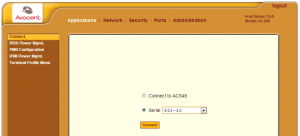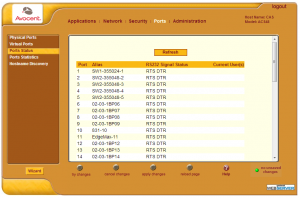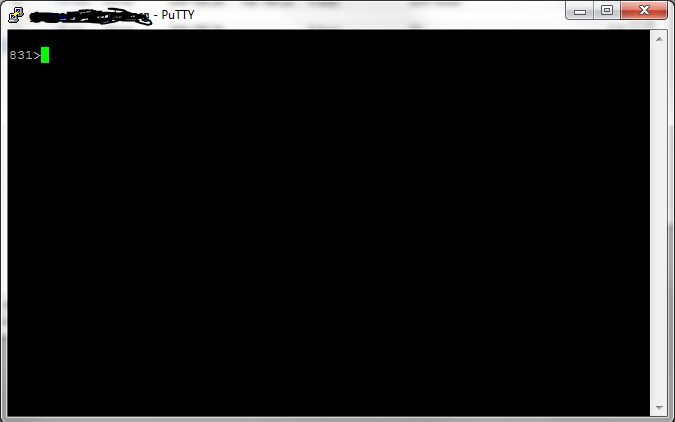Avocent Cyclades ACS48 Console Server
I have an old Cisco device that has one port for an octal-cable. This gives you 8 console ports to other routers.
Since I’ve been revamping my lab (AKA cleaning all the crap out of my room) I realized that I needed more console ports. I figured I would look on Ebay to see what I could find and low and behold, the ACS48 was a pretty good steal(I got mine for about $60 shipped).
It really looks like a 1U 48 port switch.

When I got the unit it had a config from the previous owner, so I set about correcting this. It turns out this little guy runs linux. One simply needs to boot the device in single user mode and issue the reset to default command. A fellow in the UK was nice enough to put up a tutorial!
Once that is complete you plug in it’s ethernet port, let it pull a DHCP address, then connect via a browser. You run through a quick setup wizard, then you can connect in earnest.
I chose to basically turn off all security since I’m just using it on my local LAN, but it has HTTP, HTTPS, Telnet, SSH, and direct console.
You can individually configure ports speed and settings, or just apply an across the board setting.
You also have the ability to select an individual port and connect via a java app to the terminal.

My favorite feature is the ability to telnet/ssh directly to a console port. You connect to the ACS’ IP address via port 7001 for port 1, 7002 for port 2, etc. You can even enable a login system for individual ports or as I did, have it just bridge you straight to the port. As far as security goes you can assign users/groups with varying login permissions per port. You have authentication via local, tacacs, radius, kerberos, ldap…virtually anything.
Cabling is a little odd. Everything I could find on the web said to just use a straight through cable when connecting to Cisco devices. That is exactly what I did…only it didn’t work. No matter what I did it wouldn’t work. I found that you have to swap pins 3 and 6 on one of the connectors. As soon as I changed alllll of the cable ends it worked fine. So if you use type B standard, on one of the connectors swap positions on the greenWhite and green wires. This is lame that you can’t just use regular cables, but it isn’t a deal breaker.
So far I love this device. It boots a little slow, but other than that it works exceedingly well and the price you can get these for is ridiculous.
If you pair this with an RB750 and an alternate internet connection you will have a killer OOB management solution for your network gear.





I like it!
One question, can it do serial passthrough if you have 2 of them? A serial bridge from port1 on one device to port1 on the other device, over an IP network.
@Tom
Hey kid!
I think you are asking if it can go into port1 at one side and have it pop out port1 at the far side. I don’t think it is possible. I believe you can setup “virtual ports” that will allow you to telnet to the local device and it will pass that along to the other server.
@Greg
Ah, too bad 🙂 Some of our customers still run legacy systems that need to communicate over RS485 (which we translate to RS232 with cheapo adapters) at both ends of the link, but there is only an IP network inbetween.
But use expensive Moxa RS232 bridges, and I’ve been looking for a while for a cheap way to eliminate those.
@Tom
There might be something in there, I’m just not clever enough to figure it out!
Hey Greg, thanks for the suggestion on this… I just picked up two as well.
It looks like a regular Cisco rollover cable works fine (one with RJ45 ends on both sides). I tried swapping pins 3 and 6 like you suggested, but could only receive data and not transmit.
Thanks again for the great suggestion.
@Matthew
Very cool. I don’t have a pile of rollovers, otherwise I would have tried it 😉
Hi Greg, glad to hear that my little post on resetting the config was of use to someone 🙂
Always interesting to come across another MikroTik user as well!
Ed
@Edward
Thanks for the clear, concise article! Mikrotik is making it’s way around…slowly but surely. Spreading like a virus hehe
I see several of these console servers for about the same price on ebay. Since I have no experience with console servers, if I were to pick up one of these beauties, can anyone tell me what cabling requirements I’d have connecting these to Dell servers with DB9? I was hoping I could pick up some cheapo DB9F/RJ-45 Modular Adaptors at monoprice and connect some cat5 patch cables. Anything more to it than that?
Thanks for a great post!